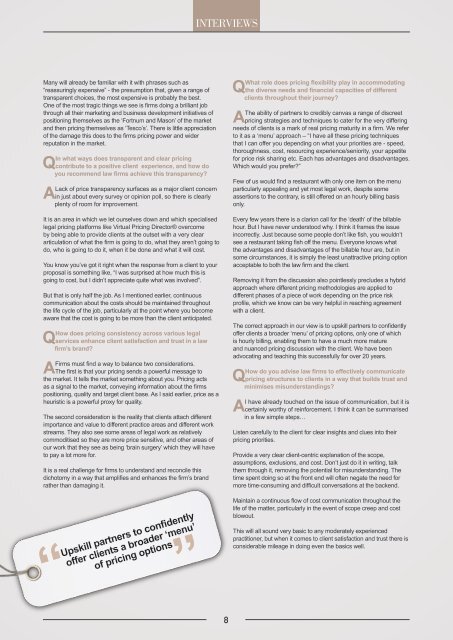Modern Law Magazine Issue 69
Create successful ePaper yourself
Turn your PDF publications into a flip-book with our unique Google optimized e-Paper software.
INTERVIEWS<br />
Many will already be familiar with it with phrases such as<br />
“reassuringly expensive” - the presumption that, given a range of<br />
transparent choices, the most expensive is probably the best.<br />
One of the most tragic things we see is firms doing a brilliant job<br />
through all their marketing and business development initiatives of<br />
positioning themselves as the ‘Fortnum and Mason’ of the market<br />
and then pricing themselves as ‘Tesco’s’. There is little appreciation<br />
of the damage this does to the firms pricing power and wider<br />
reputation in the market.<br />
In what ways does transparent and clear pricing<br />
Q contribute to a positive client experience, and how do<br />
you recommend law firms achieve this transparency?<br />
Lack of price transparency surfaces as a major client concern<br />
A in just about every survey or opinion poll, so there is clearly<br />
plenty of room for improvement.<br />
It is an area in which we let ourselves down and which specialised<br />
legal pricing platforms like Virtual Pricing Director® overcome<br />
by being able to provide clients at the outset with a very clear<br />
articulation of what the firm is going to do, what they aren’t going to<br />
do, who is going to do it, when it be done and what it will cost.<br />
You know you’ve got it right when the response from a client to your<br />
proposal is something like, “I was surprised at how much this is<br />
going to cost, but I didn’t appreciate quite what was involved”.<br />
But that is only half the job. As I mentioned earlier, continuous<br />
communication about the costs should be maintained throughout<br />
the life cycle of the job, particularly at the point where you become<br />
aware that the cost is going to be more than the client anticipated.<br />
How does pricing consistency across various legal<br />
Q services enhance client satisfaction and trust in a law<br />
firm’s brand?<br />
Firms must find a way to balance two considerations.<br />
A The first is that your pricing sends a powerful message to<br />
the market. It tells the market something about you. Pricing acts<br />
as a signal to the market, conveying information about the firms<br />
positioning, quality and target client base. As I said earlier, price as a<br />
heuristic is a powerful proxy for quality.<br />
The second consideration is the reality that clients attach different<br />
importance and value to different practice areas and different work<br />
streams. They also see some areas of legal work as relatively<br />
commoditised so they are more price sensitive, and other areas of<br />
our work that they see as being ‘brain surgery’ which they will have<br />
to pay a lot more for.<br />
It is a real challenge for firms to understand and reconcile this<br />
dichotomy in a way that amplifies and enhances the firm’s brand<br />
rather than damaging it.<br />
What role does pricing flexibility play in accommodating<br />
Q the diverse needs and financial capacities of different<br />
clients throughout their journey?<br />
The ability of partners to credibly canvas a range of discreet<br />
A pricing strategies and techniques to cater for the very differing<br />
needs of clients is a mark of real pricing maturity in a firm. We refer<br />
to it as a ‘menu’ approach – “I have all these pricing techniques<br />
that I can offer you depending on what your priorities are - speed,<br />
thoroughness, cost, resourcing experience/seniority, your appetite<br />
for price risk sharing etc. Each has advantages and disadvantages.<br />
Which would you prefer?”<br />
Few of us would find a restaurant with only one item on the menu<br />
particularly appealing and yet most legal work, despite some<br />
assertions to the contrary, is still offered on an hourly billing basis<br />
only.<br />
Every few years there is a clarion call for the ‘death’ of the billable<br />
hour. But I have never understood why. I think it frames the issue<br />
incorrectly. Just because some people don’t like fish, you wouldn’t<br />
see a restaurant taking fish off the menu. Everyone knows what<br />
the advantages and disadvantages of the billable hour are, but in<br />
some circumstances, it is simply the least unattractive pricing option<br />
acceptable to both the law firm and the client.<br />
Removing it from the discussion also pointlessly precludes a hybrid<br />
approach where different pricing methodologies are applied to<br />
different phases of a piece of work depending on the price risk<br />
profile, which we know can be very helpful in reaching agreement<br />
with a client.<br />
The correct approach in our view is to upskill partners to confidently<br />
offer clients a broader ‘menu’ of pricing options, only one of which<br />
is hourly billing, enabling them to have a much more mature<br />
and nuanced pricing discussion with the client. We have been<br />
advocating and teaching this successfully for over 20 years.<br />
How do you advise law firms to effectively communicate<br />
Q pricing structures to clients in a way that builds trust and<br />
minimises misunderstandings?<br />
I have already touched on the issue of communication, but it is<br />
A certainly worthy of reinforcement. I think it can be summarised<br />
in a few simple steps…<br />
Listen carefully to the client for clear insights and clues into their<br />
pricing priorities.<br />
Provide a very clear client-centric explanation of the scope,<br />
assumptions, exclusions, and cost. Don’t just do it in writing, talk<br />
them through it, removing the potential for misunderstanding. The<br />
time spent doing so at the front end will often negate the need for<br />
more time-consuming and difficult conversations at the backend.<br />
”<br />
”<br />
Upskill partners to confidently<br />
offer clients a broader ‘menu’<br />
of pricing options<br />
Maintain a continuous flow of cost communication throughout the<br />
life of the matter, particularly in the event of scope creep and cost<br />
blowout.<br />
This will all sound very basic to any moderately experienced<br />
practitioner, but when it comes to client satisfaction and trust there is<br />
considerable mileage in doing even the basics well.<br />
8
















